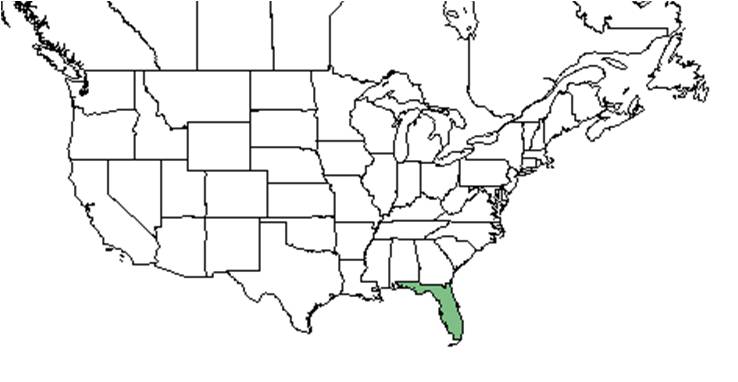Difference between revisions of "Hypericum edisonianum"
KatieMccoy (talk | contribs) |
KatieMccoy (talk | contribs) |
||
| Line 34: | Line 34: | ||
===Phenology=== <!--Timing off flowering, fruiting, seed dispersal, and environmental triggers. Cite PanFlora website if appropriate: http://www.gilnelson.com/PanFlora/ --> | ===Phenology=== <!--Timing off flowering, fruiting, seed dispersal, and environmental triggers. Cite PanFlora website if appropriate: http://www.gilnelson.com/PanFlora/ --> | ||
| − | + | The amount of flowers in anthesis within ramets are limited and independent of one another because individual flower are short lived and flowering occurs throughout the year (Abrahamson and Vander Kloet 2014). | |
===Seed dispersal=== | ===Seed dispersal=== | ||
Revision as of 14:32, 5 January 2016
| Hypericum edisonianum | |
|---|---|

| |
| Scientific classification | |
| Kingdom: | Plantae |
| Division: | Magnoliophyta - Flowering plants |
| Class: | Magnoliopsida - Dicotyledons |
| Order: | Theales |
| Family: | Clusiaceae ⁄ Guttiferae |
| Genus: | Hypericum |
| Species: | H. edisonianum |
| Binomial name | |
| Hypericum edisonianum (Small) P. Adams & N. Robson | |

| |
| Natural range of Hypericum edisonianum from USDA NRCS Plants Database. | |
Common name: Arcadian St. Johnswort
Contents
Taxonomic notes
Description
H. edisonianum is a multi-branched evergreen shrub that forms extensive thickets. The stems are thin and dark with silvery black bark, and are leafless except for the upper branches. Leaves are opposite, oval, gland-dotted abaxially. The flowers are composed of 4 yellow petals, 2 large sepals with pointed tips and rounded bases [1].
This species exhibits traits that are common to rare and geographically limited plant species such as : (a) heavy reliance on clonal propagation to maintain local stands (b) passive seed dispersal resulting in a near-parent seed shadow (c) limited numbers of genetically unique individuals in isolated seasonal pond habitat (d) self-incompatibility (Abrahamson and Vander Kloet 2014).
Distribution
Its range is limited to the scrubs of the central peninsular Florida in Highlands, Polk, Glades, DeSoto, and Collier counties (Abrahamson and Vander Kloet 2014). Excessive drainage, agriculture, and urban development are locally eliminating the species in this range (Ward 1979).
Ecology
Habitat
In the central peninsular counties of Florida, H. edisonianum has been found in ephemeral ponds, flatwood ponds, and wet swales in low pine-palmetto flats, cutthroat grass seeps, and along lake margins (Abrahamson and Vander Kloet 2014; FSU Herbarium). It tends to form dense thickets of ramets in poorly drained sandy sites that have a low pH, little organic matter, and low nutrient status, such as seasonal ponds (Abrahamson and Vander Kloet 2014). Associated species include Andropogon brachystachyus, Ascyrum tetrapetalum, and Ascyrum hypericoides. Soils have been recorded as Paola-Basinger (Spodic Quartzipsamments) (FSU Herbarium).
Phenology
The amount of flowers in anthesis within ramets are limited and independent of one another because individual flower are short lived and flowering occurs throughout the year (Abrahamson and Vander Kloet 2014).
Seed dispersal
Seed bank and germination
Fire ecology
Pollination
The following Hymenoptera families and species were observed visiting flowers of Hypericum edisonianum at Archbold Biological Station (Deyrup 2015):
Apidae: Apis mellifera, Bombus impatiens, B. pennsylvanicus
Colletidae: Hylaeus confluens, H. schwarzi
Halictidae: Augochloropsis sumptuosa, Lasioglossum miniatulus, L. nymphalis, L. pectoralis, L. placidensis, L. puteulanum
Megachilidae: Anthidiellum perplexum, Megachile brevis pseudobrevis, M. mendica, M. petulans
Use by animals
Diseases and parasites
Conservation and Management
Cultivation and restoration
Photo Gallery
References and notes
Deyrup, M.A. and N.D. 2015. Database of observations of Hymenoptera visitations to flowers of plants on Archbold Biological Station, Florida, USA.
Florida State University Robert K. Godfrey Herbarium database. URL: http://herbarium.bio.fsu.edu. Last accessed: October 2015. Collectors: W.P. Adams, Leonard J. Brass, Edwin L. Bridges, George R. Cooley, R.K. Godfrey, Colleen Hoy, Beverly Judd, Walter S. Judd, Steve L. Orzell, Grady W. Reinert, Joe Testasecca, Daniel B. Ward, Kenneth A. Wilson, Carroll E. Wood. States and Counties: Florida: Glades, Highlands. Compiled by Tall Timbers Research Station and Land Conservancy.